第3章 ASIC设计流程
- 格式:ppt
- 大小:153.50 KB
- 文档页数:50
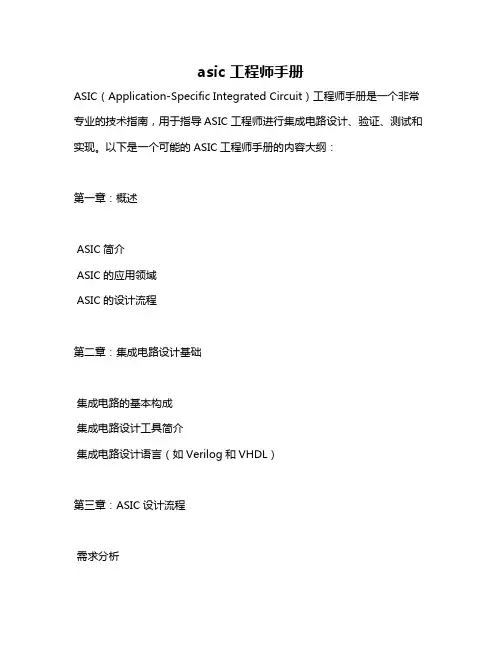
asic 工程师手册
ASIC(Application-Specific Integrated Circuit)工程师手册是一个非常专业的技术指南,用于指导ASIC工程师进行集成电路设计、验证、测试和实现。
以下是一个可能的ASIC工程师手册的内容大纲:
第一章:概述
ASIC简介
ASIC的应用领域
ASIC的设计流程
第二章:集成电路设计基础
集成电路的基本构成
集成电路设计工具简介
集成电路设计语言(如Verilog和VHDL)
第三章:ASIC设计流程
需求分析
规格说明
架构设计
逻辑设计
物理设计
布线与布局
测试与验证
第四章:ASIC验证方法
仿真验证
形式验证
静态时序分析(STA)
物理验证(DRC/LVS)
第五章:ASIC测试技术
测试策略与测试计划
测试向量生成
内建自测试(BIST)
故障模拟与故障覆盖率分析
第六章:ASIC实现与版图绘制
工艺选择与参数提取
设计版图生成与后端物理合成
DFM(可制造性设计)考虑因素
最终版图检查与验证
第七章:ASIC制程与封装
制程技术简介
封装技术与材料选择
制程与封装测试方法
第八章:ASIC可靠性与可靠性分析
ASIC可靠性概述
环境应力对ASIC的影响
ASIC可靠性分析方法与工具介绍(如加速寿命测试、失效模式和效应分析)第九章:ASIC设计案例研究
案例一:数字信号处理(DSP)ASIC设计实例案例二:通信系统ASIC设计实例
案例三:高性能计算(HPC)ASIC设计实例。

ASIC TechnologyA Brief Introduction To The ASIC TechnologyAnd It's Design FlowASIC DesignLecture 3: ASIC Structures & Design Flow1.IC Manufacturing2.CMOS Technology3.ASIC –Structures & DesignFlow4.FPGA –Technology &Devices5.HDLs and Synthesis6.Digital Design Methodology7.Simulation digital8.Simulation analog/mixed 9.IC Production Test10.HW/SW Design andVerification11.µP, µC, DSPparing ASIC/FPGA vs.µP/µC13.Managing ASIC-Projects14.IC Packaging and IO15.Future TrendsContents9We will examine different ASIC structures and classify them•ASIC, Gate Array, FPGA, etc9We will have a closer look to the custom ICs9We will learn about the basic ASIC design flow9We will compare digital with analog design flowClassification9There are many different possible classification schemes9We will use a scheme based on the programming technology9ASICs may be divided into two major classes:–Mask Programmable ASICs(MPGAs)Programmed during manufacturing in the fab–User Programmable Logic Devices (UPLDs) Programmed by the user on the deskClassificationASICApplication Specific Integrated CircuitsMPGA Mask Programmable Gate ArraysUPLDUser ProgrammableLogic DevicesCPLDComplex ProgrammableLogic DevicesGate ArraySea of Gates Embedded Arrays Standard CellCore Based DesignFPGAField ProgrammableGate ArraysFPICField ProgrammableInterconnect CircuitsCrossbarArray of Logic•LUT•NAND•MUX•Wide GatesMultipleAND/OR MatricesCustom ICs9Now we will have a more closer look to the MPGAs9They are also called:–Custom ICs–ASICs9This is sometimes quite confusing since the term "ASIC" is also used as a term denoting all userspecific ICs and thus including user programmable logic devices.Full Custom ICs9Irregular blocksI/O pads and logic cellsirregulararray ofcellsExamples:•processors•memoryConcept of the "Gate"9Use a pre-defined building block -the "Gate"9Compose all logic functions out of this basic elementVDD railp-channel MOSFETn-channel MOSFETVSS railA Gate Configured as a NAND9The function is defined by two or three masks•Typically poly silicon, metal1, metal2VDD railp-channel MOSFETVSS railn-channel MOSFETas = a & bbGate Array9Array of gates surrounded by a pad ring 9Large routing channels•Simple one-dimensional routing•Fixed logic/routing ratioI/O padsregular array ofgates withrouting channelrouting channelSea of Gate Arrays9Routing is performed across the gates •Requires more metal layers•Flexible logic/routing ratioI/O padsregular array ofgates withoutany routingchannelEmbedded Arrays9They include large compiled regular blocks•RAM, ROM, multiplier, etc.embeddedoptimizedcore blockembeddedoptimized core blockpad ring sea of gatesProgrammable Logic9We will have just a brief view to the programmable logic devices9To compare them to custom ICs9FPGAs and CPLDs are that important that there is a separate lecture covering just these devices9FPGAs are similar to gate arrays9User programmable logic cells9Cells may be simple NANDs, MUX, or LUTs9Programmable interconnects–Different levels of interconnects•Short, medium, long, clock–Main drawback compared to gate arrays•System performance limited by interconnections•Programmability requires area and introduces additional delay9Multiple blocks of AND/OR blocks 9PAL-like structureVolumes and ComplexityTechnology Volume Gates Standard Cell> 100k50k -10M Sea of Gates> 100k30k -5M Embedded Array> 50k50k-1M Gate Array50k -100k50k -300k FPGA 1 -10k1k -5M CPLD 1 -10k400 -100kTypical CostsTechnology NRE (€)€/pcs. Standard Cell100k -2M smallestSea of Gates30k –200k small Embedded Array 30k -100k smallGate Array20k -50k smallFPGA small 5 -10kCPLD small 1 -100Notice:9Prices are just a figure to compare the technologies. 9Costs vary with a large number of factors.Device Cost vs. Volume9Rule of thumb$/chipchipsFPGAsFull CustomGate Arrays9Now we will examine the ASIC design flow•The road from concepts to Silicon9There are EDA tools that support each level of design abstraction9We start first with a simple generic design flow9We continue discussing some design principles9Finally we will have a more closer look to the design flow and the EDA tools requiredideaspecification system level design system levelsimulationcircuit architecture designarchitecturesimulationsynthesizeable netlist register transfer level(RTL)circuit designpre-layoutsimulation gate level netlist pre-layoutphysical designpost-layoutsimulation gate level netlist post-layoutproduction test generation production testsimulationsign-off9There are some basic requirements or principles for the design flow•They are valid for every technology like ASIC, FPGA, MCM,PCB etc.9Consistency• A consistent data base of all design related data from designentry through verification down to production data•Controlled access for team members9Automation•Speed up the design flow by automating tasks•Use scripting capabilities•Use sophisticated EDA tools•Perform each design step on highest level possible9Flexibility•Combine tools from different vendors•Support standardized interfaces•Enable continuously adaptation of design methodology•Support distributed design teams9Repeatability•Every design step has to be repeatable and documented•Basic requirement to maintain quality9Design iterations have to converge•Every loop in the design flow should bring up considerably lessdesign rule violations9Every design step is followed by a verification phase •Feedback principle•Required also for purely automated tasks since complex EDAtools might introduce some errors9Embedded verification•Every design step is accompanied by a verification•Actually design entry requires just 20-30% of the time budget•Rest of time is spent for verification9System design & verification•Model and verify the interaction of the design and itsenvironment•Model larger electronic systems including software•Model also mechanical systems etc.9Just think of entering an elevator•No one likes the idea of a blue screen or crash when pushingthe key for the first floor9Deal with the ever increasing complexity of the integrated circuits•Well known as Moore‘s law9Formulated by Gordon Moore in the 1960s •Gordon Moore was a founder of Intel•The average circuit density doubles every 18 months9This is the silicon industry basic economic “law”•Although somewhat a self fulfilling prophesy•This is now more or less valid for more than 30 years9Beside the increasing complexity we have to deal with other problems too•Performance increases factor 10 every 8 years•Power consumption increases factor 10 every 6 years•Test vectors increases factor 1000 every 6 years9Now let’s have a look to the design flow from a more technical point of viewsystem simulationtool/library setup design capture functional simulationsynthesis generated blocks IP blocksfloorplanningstatic timing analysisequivalence checking test design RTL DESIGNSYNTHESISSYSTEM DESIGNpost synthesis simulationdetailed routingglobal routingplacementtiming extractiontest simulation SYNTHESISPHYSICAL DESIGNpost layout simulationstatic timing analysistest simulation tester rules validation equivalence checkingLVSDRCPHYSICAL VERIFICATIONPOST LAYOUT VERIFICATION9Tools:–“Simple” text editor (language sensitive)•XEmacs, WinEdit, or even Notepad or vi –Simulator•Modeltech: Modelsim•Synopsys: VSS, VCS•Cadence: Leapfrog, Verilog-XL–Revision control system•RCS, CVS9Input:–HDL design files and testbenches•Do it yourself–IP blocks•From an IP vendor–Generated blocks, hard macros•From the ASIC/FPGA vendor9Output:•Information whether your design behaves as specified. 9Abstraction level:•Cycle based9Tools:–Synthesis•Synopsys: DesignCompiler•Cadence: Ambit–Test Synthesis•Synopsys: TestCompiler –Power Synthesis•Synopsys: PowerCompiler 9Input:–HDL design files–Technology library•From ASIC vendor–Design constraints•Time, area, test, clock, power, hierarchical, floorplan 9Output:–Design database•Different levels–Reports•Constraints, time, area, power–Gate level netlist•any HDL and EDIF9Abstraction level:•Gate level•Full gate timing, estimated routing timing9Tools:–Test Synthesis•Synopsys: TestCompiler, TetraMAX–Fault Simulation•Synopsys: TetraMAX•Cadence: Verifault XL–ATPG –Automatic Test Pattern Generation •Synopsys: TetraMAX9Input:–Gate level netlist•From synthesis tools–Technology library•From ASIC vendor9Output:–Gate level netlist with test structures inserted •Full/partial scan test•IDDQ test–Production test pattern9Abstraction level:•TransistorPhysical Design9Tools:–Clock tree synthesis–Placement–Detailed/global routing–Timing extraction–There are huge design frameworks available •Cadence•Synopsys•Avant!9Input:–Gate level netlist from synthesis –I/O placement(pinout)–Constraints•Timing, placement, routing–Floorplan–Clock distribution scheme–Technology library9Output:–Layout database–Extracted timing information •Usually SDF–Extracted layout netlist•Any HDL and EDIF–Mask data•Usually GDSII9Abstraction level:•Transistor level•Full gate and routing timing9Tools:–ERC–DRC–LVS9Input:–Gate level netlist from synthesis –Layout database–Mask data9Output:–Design electrically ok–All technology rules are ok–Mask data is consistent with pre-layout netlist9Abstraction level:•Transistor level and beyondDesign Flow Trends9Due to second order effects that have to be modeled for nowadays DSM designs the classical design flow changes a little bit•Each design steps requires a lot of interaction• E.g. synthesis and placement are no longer a separate taskbut have to done in “parallel”9Interconnection defines the performance•Both area and delay9Up to now we concentrated on digital ICs•But what about analog and mixed signal ICs?•Is there a difference in the design flow?9Analog design is about controlling some couple of thousands transistors•Instead of some 100 millions as for digital design9Analog design requires more detailed simulation •There is no simple state reduction possible as done for digitalsimulation•Analog simulators like SPICE are required9Analog simulation thus requires more computing performance•That‘s why one is limited in the design’s complexity9Due to the complexity of analog design there is only limited support for design automation• A lot of hand crafting is still necessary9Design principles are still the same•More on this topic will be discussed in the lecture “Analog andmixed signal simulation”Floorplanning Placement Routing Sign OffLVSERCDRCSpecificationCircuit DevelopmentTest Specification SimulationCell DesignCell Layout9Now we will have a look to the ASIC design flow from the commercial perspective•More details on this topic will be discussed in the lecture “ASICmanagement and design interfaces”9Goal is to give a basic understanding of the sequence of events of an industrial ASIC designideadraft spec.ASIC vendor feasibility study IP vendor 12 weeksfinal spec.project kick off。
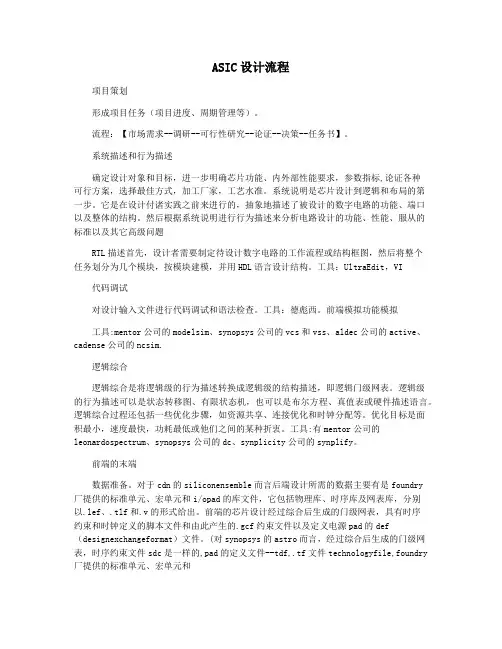
ASIC设计流程项目策划形成项目任务(项目进度、周期管理等)。
流程:【市场需求--调研--可行性研究--论证--决策--任务书】。
系统描述和行为描述确定设计对象和目标,进一步明确芯片功能、内外部性能要求,参数指标,论证各种可行方案,选择最佳方式,加工厂家,工艺水准。
系统说明是芯片设计到逻辑和布局的第一步。
它是在设计付诸实践之前来进行的,抽象地描述了被设计的数字电路的功能、端口以及整体的结构。
然后根据系统说明进行行为描述来分析电路设计的功能、性能、服从的标准以及其它高级问题RTL描述首先,设计者需要制定待设计数字电路的工作流程或结构框图,然后将整个任务划分为几个模块,按模块建模,并用HDL语言设计结构。
工具:UltraEdit,VI代码调试对设计输入文件进行代码调试和语法检查。
工具:德彪西。
前端模拟功能模拟工具:mentor公司的modelsim、synopsys公司的vcs和vss、aldec公司的active、cadense公司的ncsim.逻辑综合逻辑综合是将逻辑级的行为描述转换成逻辑级的结构描述,即逻辑门级网表。
逻辑级的行为描述可以是状态转移图、有限状态机,也可以是布尔方程、真值表或硬件描述语言。
逻辑综合过程还包括一些优化步骤,如资源共享、连接优化和时钟分配等。
优化目标是面积最小,速度最快,功耗最低或他们之间的某种折衷。
工具:有mentor公司的leonardospectrum、synopsys公司的dc、synplicity公司的synplify。
前端的末端数据准备。
对于cdn的siliconensemble而言后端设计所需的数据主要有是foundry厂提供的标准单元、宏单元和i/opad的库文件,它包括物理库、时序库及网表库,分别以.lef、.tlf和.v的形式给出。
前端的芯片设计经过综合后生成的门级网表,具有时序约束和时钟定义的脚本文件和由此产生的.gcf约束文件以及定义电源pad的def (designexchangeformat)文件。
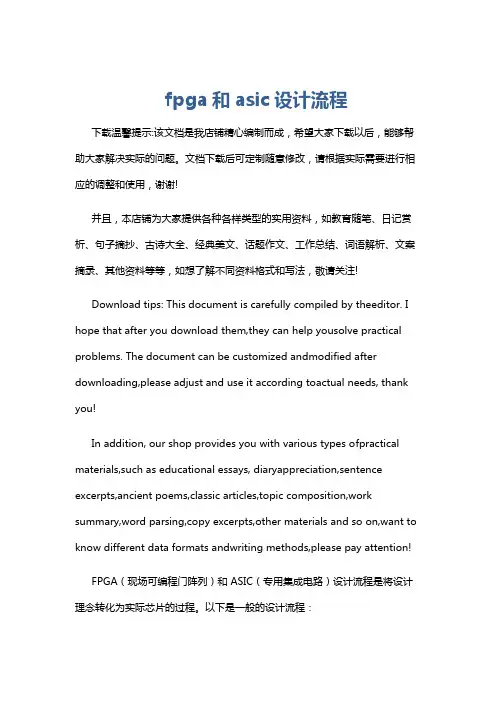
fpga和asic设计流程下载温馨提示:该文档是我店铺精心编制而成,希望大家下载以后,能够帮助大家解决实际的问题。
文档下载后可定制随意修改,请根据实际需要进行相应的调整和使用,谢谢!并且,本店铺为大家提供各种各样类型的实用资料,如教育随笔、日记赏析、句子摘抄、古诗大全、经典美文、话题作文、工作总结、词语解析、文案摘录、其他资料等等,如想了解不同资料格式和写法,敬请关注!Download tips: This document is carefully compiled by theeditor. I hope that after you download them,they can help yousolve practical problems. The document can be customized andmodified after downloading,please adjust and use it according toactual needs, thank you!In addition, our shop provides you with various types ofpractical materials,such as educational essays, diaryappreciation,sentence excerpts,ancient poems,classic articles,topic composition,work summary,word parsing,copy excerpts,other materials and so on,want to know different data formats andwriting methods,please pay attention!FPGA(现场可编程门阵列)和 ASIC(专用集成电路)设计流程是将设计理念转化为实际芯片的过程。
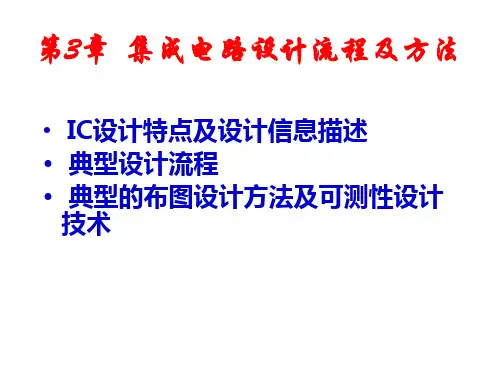
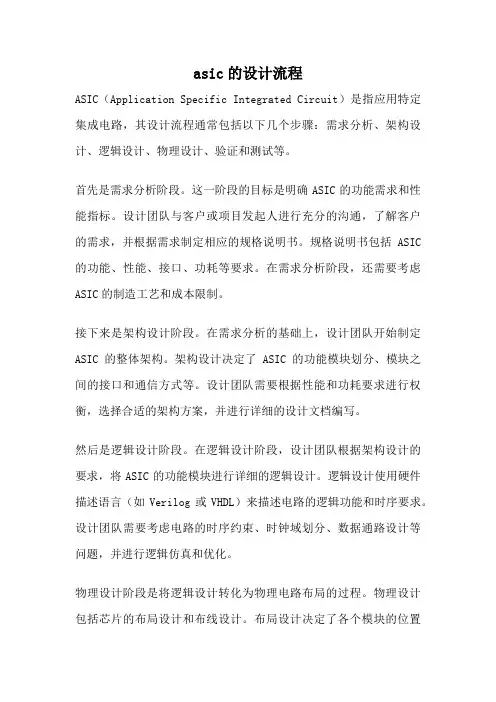
asic的设计流程ASIC(Application Specific Integrated Circuit)是指应用特定集成电路,其设计流程通常包括以下几个步骤:需求分析、架构设计、逻辑设计、物理设计、验证和测试等。
首先是需求分析阶段。
这一阶段的目标是明确ASIC的功能需求和性能指标。
设计团队与客户或项目发起人进行充分的沟通,了解客户的需求,并根据需求制定相应的规格说明书。
规格说明书包括ASIC 的功能、性能、接口、功耗等要求。
在需求分析阶段,还需要考虑ASIC的制造工艺和成本限制。
接下来是架构设计阶段。
在需求分析的基础上,设计团队开始制定ASIC的整体架构。
架构设计决定了ASIC的功能模块划分、模块之间的接口和通信方式等。
设计团队需要根据性能和功耗要求进行权衡,选择合适的架构方案,并进行详细的设计文档编写。
然后是逻辑设计阶段。
在逻辑设计阶段,设计团队根据架构设计的要求,将ASIC的功能模块进行详细的逻辑设计。
逻辑设计使用硬件描述语言(如Verilog或VHDL)来描述电路的逻辑功能和时序要求。
设计团队需要考虑电路的时序约束、时钟域划分、数据通路设计等问题,并进行逻辑仿真和优化。
物理设计阶段是将逻辑设计转化为物理电路布局的过程。
物理设计包括芯片的布局设计和布线设计。
布局设计决定了各个模块的位置和相互之间的关系,布线设计则将逻辑电路转化为实际的物理连线。
物理设计需要考虑芯片的面积、功耗、时钟分布等因素,并进行电磁兼容性分析和时序收敛等。
验证和测试是ASIC设计流程中非常重要的一步。
验证的目标是确保设计的正确性和功能的完整性。
验证过程包括功能验证、时序验证和电气验证等。
功能验证通过对设计的功能模块进行仿真和测试,验证其是否符合规格说明书的要求。
时序验证则是验证时序约束是否满足,以确保电路能够正常工作。
电气验证则是验证电路的电气特性,例如功耗、噪声等。
测试阶段主要是通过实际的芯片测试来验证设计的正确性和性能指标。
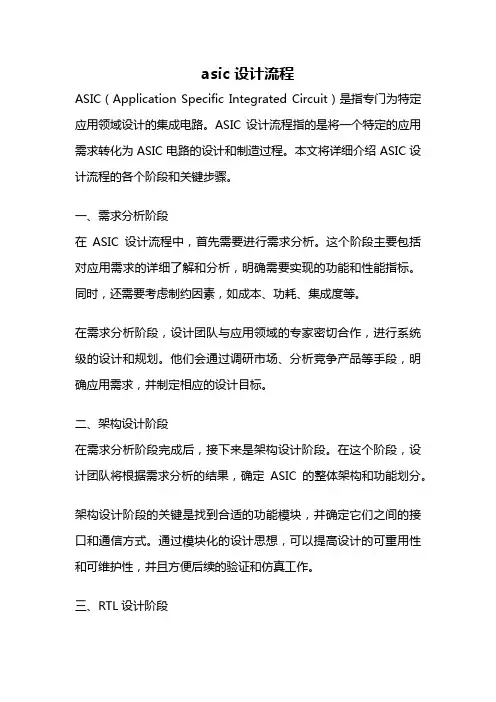
asic 设计流程ASIC(Application Specific Integrated Circuit)是指专门为特定应用领域设计的集成电路。
ASIC设计流程指的是将一个特定的应用需求转化为ASIC电路的设计和制造过程。
本文将详细介绍ASIC设计流程的各个阶段和关键步骤。
一、需求分析阶段在ASIC设计流程中,首先需要进行需求分析。
这个阶段主要包括对应用需求的详细了解和分析,明确需要实现的功能和性能指标。
同时,还需要考虑制约因素,如成本、功耗、集成度等。
在需求分析阶段,设计团队与应用领域的专家密切合作,进行系统级的设计和规划。
他们会通过调研市场、分析竞争产品等手段,明确应用需求,并制定相应的设计目标。
二、架构设计阶段在需求分析阶段完成后,接下来是架构设计阶段。
在这个阶段,设计团队将根据需求分析的结果,确定ASIC的整体架构和功能划分。
架构设计阶段的关键是找到合适的功能模块,并确定它们之间的接口和通信方式。
通过模块化的设计思想,可以提高设计的可重用性和可维护性,并且方便后续的验证和仿真工作。
三、RTL设计阶段在架构设计阶段确定了ASIC的整体框架后,接下来是RTL (Register Transfer Level)设计阶段。
在这个阶段,设计团队将使用硬件描述语言(如Verilog、VHDL)来描述和实现ASIC的功能模块。
RTL设计阶段的关键是将功能模块转化为硬件逻辑电路。
设计团队需要仔细考虑时序和逻辑的优化,以提高电路的性能和功耗。
同时,还需要进行功能仿真和时序约束等工作,确保设计的正确性和可靠性。
四、综合与布局布线阶段在RTL设计阶段完成后,接下来是综合与布局布线阶段。
在这个阶段,设计团队将进行逻辑综合、布局和布线等工作,将RTL描述的电路转化为物理电路。
综合是将RTL描述的电路转化为门级网表电路的过程。
在综合过程中,设计团队需要进行逻辑优化和面积约束等工作,以提高电路的性能和集成度。
布局和布线是将门级网表电路映射到实际的芯片布局上的过程。
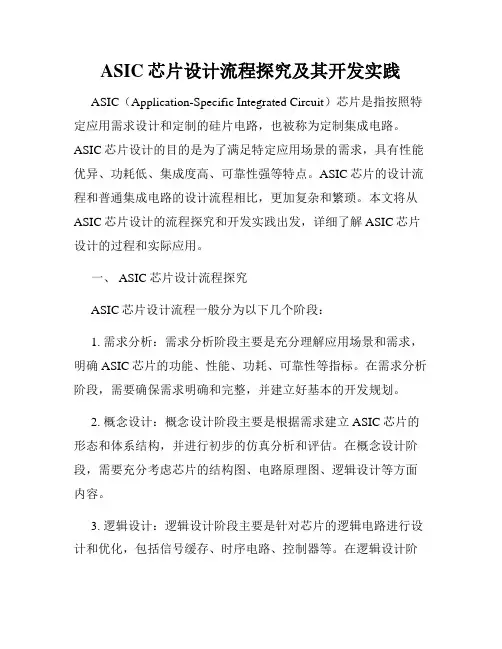
ASIC芯片设计流程探究及其开发实践ASIC(Application-Specific Integrated Circuit)芯片是指按照特定应用需求设计和定制的硅片电路,也被称为定制集成电路。
ASIC芯片设计的目的是为了满足特定应用场景的需求,具有性能优异、功耗低、集成度高、可靠性强等特点。
ASIC芯片的设计流程和普通集成电路的设计流程相比,更加复杂和繁琐。
本文将从ASIC芯片设计的流程探究和开发实践出发,详细了解ASIC芯片设计的过程和实际应用。
一、 ASIC芯片设计流程探究ASIC芯片设计流程一般分为以下几个阶段:1. 需求分析:需求分析阶段主要是充分理解应用场景和需求,明确ASIC芯片的功能、性能、功耗、可靠性等指标。
在需求分析阶段,需要确保需求明确和完整,并建立好基本的开发规划。
2. 概念设计:概念设计阶段主要是根据需求建立ASIC芯片的形态和体系结构,并进行初步的仿真分析和评估。
在概念设计阶段,需要充分考虑芯片的结构图、电路原理图、逻辑设计等方面内容。
3. 逻辑设计:逻辑设计阶段主要是针对芯片的逻辑电路进行设计和优化,包括信号缓存、时序电路、控制器等。
在逻辑设计阶段,需要结合芯片结构进行仿真计算,并进行性能优化和需求调整。
4. 物理设计:物理设计阶段主要是根据逻辑电路图进行器件布局,包括栅极、源漏区域、金属线路等。
在物理设计阶段,需要根据制造工艺和特定应用场景进行微调和优化。
5. 验证测试:验证测试阶段主要是对ASIC芯片进行功能验证和性能测试,包括环境适应性测试、可靠性测试、温度测试等。
在验证测试阶段,需要充分考虑市场需求和投入产出比等方面内容。
6. 授权生产:授权生产阶段主要是将ASIC芯片的设计文件和制造工艺交给制造厂家进行批量生产。
在授权生产阶段,需要充分考虑品质控制和成本控制等方面问题。
二、ASIC芯片设计开发实践ASIC芯片的设计开发实践存在着以下几个难点:1. 设计周期长:ASIC芯片开发需要经历多个阶段复杂的设计过程,设计周期长、成本较高、风险较大。
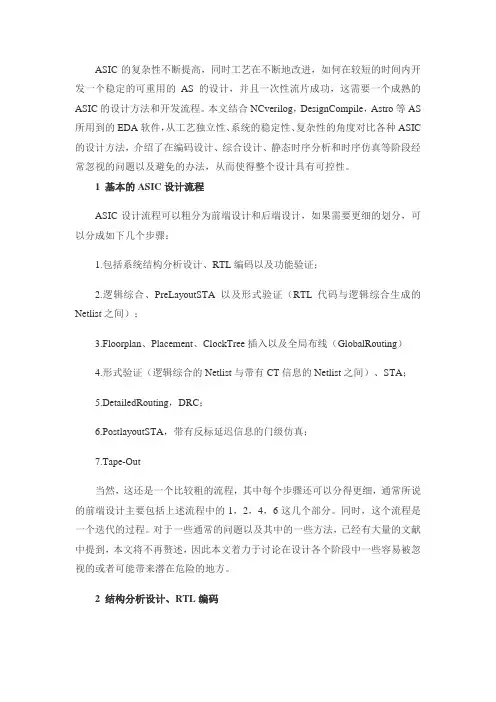
ASIC的复杂性不断提高,同时工艺在不断地改进,如何在较短的时间内开发一个稳定的可重用的AS的设计,并且一次性流片成功,这需要一个成熟的ASIC的设计方法和开发流程。
本文结合NCverilog,DesignCompile,Astro等AS 所用到的EDA软件,从工艺独立性、系统的稳定性、复杂性的角度对比各种ASIC 的设计方法,介绍了在编码设计、综合设计、静态时序分析和时序仿真等阶段经常忽视的问题以及避免的办法,从而使得整个设计具有可控性。
1 基本的ASIC设计流程ASIC设计流程可以粗分为前端设计和后端设计,如果需要更细的划分,可以分成如下几个步骤:1.包括系统结构分析设计、RTL编码以及功能验证;2.逻辑综合、PreLayoutSTA以及形式验证(RTL代码与逻辑综合生成的Netlist之间);3.Floorplan、Placement、ClockTree插入以及全局布线(GlobalRouting)4.形式验证(逻辑综合的Netlist与带有CT信息的Netlist之间)、STA;5.DetailedRouting,DRC;6.PostlayoutSTA,带有反标延迟信息的门级仿真;7.Tape-Out当然,这还是一个比较粗的流程,其中每个步骤还可以分得更细,通常所说的前端设计主要包括上述流程中的1,2,4,6这几个部分。
同时,这个流程是一个迭代的过程。
对于一些通常的问题以及其中的一些方法,已经有大量的文献中提到,本文将不再赘述,因此本文着力于讨论在设计各个阶段中一些容易被忽视的或者可能带来潜在危险的地方。
2 结构分析设计、RTL编码这一阶段在整个ASIC设计中占非常重要的地位,结构分析设计阶段主要是从产品的功能定义出发,对产品采用的工艺、功耗、面积、性能以及代价进行初步的评估,从而制定相应的设计规划,对于规模很大的ASIC设计,在这一阶段估算芯片的功耗面积非常困难。
在这里引入一个ASIC设计中很重要的概念:划分(Partitioning),在不同的设计阶段这个概念都将提到。
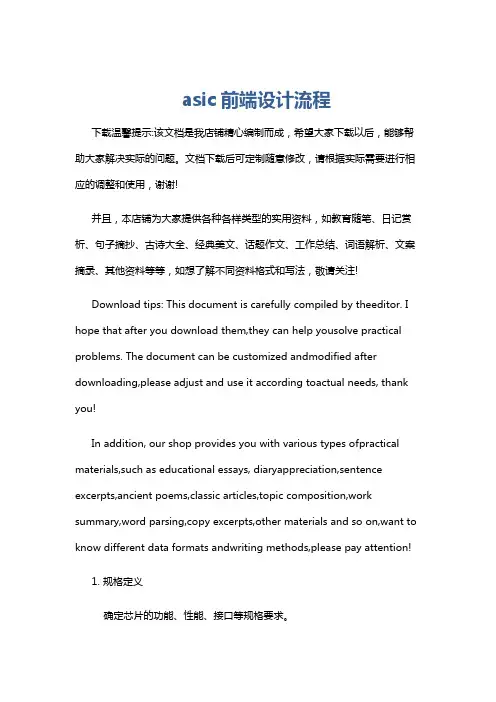
asic前端设计流程下载温馨提示:该文档是我店铺精心编制而成,希望大家下载以后,能够帮助大家解决实际的问题。
文档下载后可定制随意修改,请根据实际需要进行相应的调整和使用,谢谢!并且,本店铺为大家提供各种各样类型的实用资料,如教育随笔、日记赏析、句子摘抄、古诗大全、经典美文、话题作文、工作总结、词语解析、文案摘录、其他资料等等,如想了解不同资料格式和写法,敬请关注!Download tips: This document is carefully compiled by theeditor. I hope that after you download them,they can help yousolve practical problems. The document can be customized andmodified after downloading,please adjust and use it according toactual needs, thank you!In addition, our shop provides you with various types ofpractical materials,such as educational essays, diaryappreciation,sentence excerpts,ancient poems,classic articles,topic composition,work summary,word parsing,copy excerpts,other materials and so on,want to know different data formats andwriting methods,please pay attention!1. 规格定义确定芯片的功能、性能、接口等规格要求。
与系统工程师、算法工程师等进行沟通,明确设计目标。
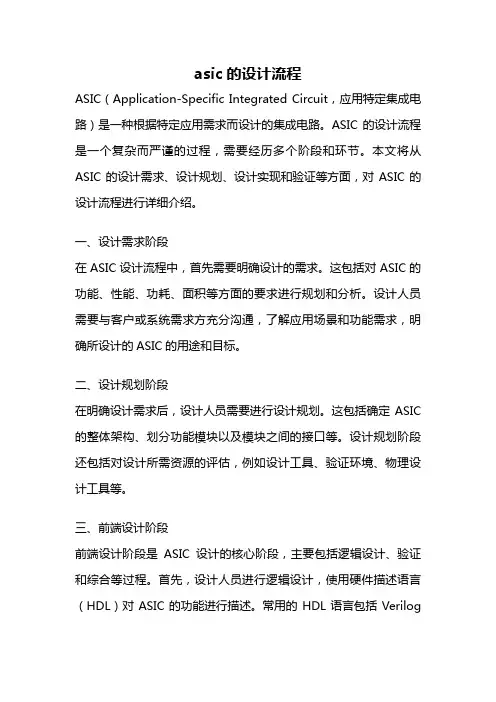
asic的设计流程ASIC(Application-Specific Integrated Circuit,应用特定集成电路)是一种根据特定应用需求而设计的集成电路。
ASIC的设计流程是一个复杂而严谨的过程,需要经历多个阶段和环节。
本文将从ASIC的设计需求、设计规划、设计实现和验证等方面,对ASIC的设计流程进行详细介绍。
一、设计需求阶段在ASIC设计流程中,首先需要明确设计的需求。
这包括对ASIC的功能、性能、功耗、面积等方面的要求进行规划和分析。
设计人员需要与客户或系统需求方充分沟通,了解应用场景和功能需求,明确所设计的ASIC的用途和目标。
二、设计规划阶段在明确设计需求后,设计人员需要进行设计规划。
这包括确定ASIC 的整体架构、划分功能模块以及模块之间的接口等。
设计规划阶段还包括对设计所需资源的评估,例如设计工具、验证环境、物理设计工具等。
三、前端设计阶段前端设计阶段是ASIC设计的核心阶段,主要包括逻辑设计、验证和综合等过程。
首先,设计人员进行逻辑设计,使用硬件描述语言(HDL)对ASIC的功能进行描述。
常用的HDL语言包括Verilog和VHDL。
在逻辑设计完成后,设计人员需要进行验证工作,以确保设计的正确性和可靠性。
验证工作包括功能仿真、时序仿真和形式验证等。
验证通过后,设计人员进行综合,将逻辑设计转化为门级网表。
综合工具会根据目标芯片的库文件和约束条件生成门级网表。
四、物理设计阶段物理设计阶段主要包括布局设计、布线设计和时序优化等过程。
布局设计是将门级网表映射到目标芯片上,确定各个功能模块的位置和布局规则。
布线设计是在布局的基础上,将各个功能模块之间的连线进行布线,以满足时序和面积等约束条件。
时序优化是通过对时序路径进行优化,以提高ASIC的工作频率和性能。
五、后端设计阶段后端设计阶段主要包括物理验证、版图提取和静态时序分析等过程。
物理验证是为了验证物理设计的正确性和可靠性,包括DRC (Design Rule Check)、LVS(Layout versus Schematic)等验证。
asic的设计流程ASIC(Application Specific Integrated Circuit)是一种专用集成电路,用于特定应用领域的定制设计。
ASIC的设计流程是一个复杂而系统的过程,涉及到多个阶段和环节。
本文将详细介绍ASIC的设计流程,并探讨每个阶段的重要性和具体步骤。
ASIC的设计流程可以大致分为需求分析、架构设计、逻辑设计、验证与仿真、物理设计、制造与测试等阶段。
下面将逐一介绍这些阶段的内容。
首先是需求分析阶段。
在这个阶段,设计团队与客户充分沟通,明确ASIC的功能需求和性能指标。
设计团队要了解客户的需求,包括应用场景、功能要求、性能要求等。
通过需求分析,设计团队可以明确设计目标,为后续的设计工作奠定基础。
接下来是架构设计阶段。
在这个阶段,设计团队根据需求分析的结果,确定ASIC的整体结构和功能模块划分。
设计团队要考虑各个功能模块之间的接口和通信方式,确保整个系统的协调运行。
架构设计是ASIC设计的核心,决定了后续设计工作的方向和重点。
然后是逻辑设计阶段。
在这个阶段,设计团队将系统的功能模块转化为逻辑电路。
根据架构设计的要求,设计团队使用硬件描述语言(如VHDL或Verilog)进行逻辑设计,包括电路的逻辑门实现、电路的时序控制、电路的状态机设计等。
逻辑设计是ASIC设计的关键环节,要求设计团队具备扎实的逻辑电路知识和编程技巧。
接着是验证与仿真阶段。
在这个阶段,设计团队对逻辑设计进行功能验证和时序仿真。
功能验证是为了验证逻辑电路是否符合需求,能够实现预期的功能。
时序仿真是为了验证电路的时序控制和时序约束是否满足要求。
通过验证与仿真,设计团队可以发现和修复设计中的错误和问题,确保ASIC的正确性和可靠性。
然后是物理设计阶段。
在这个阶段,设计团队将逻辑电路转化为物理电路,包括电路的布局设计和电路的布线设计。
布局设计是将逻辑电路映射到实际的芯片布局上,考虑电路的面积利用率和信号传输的延迟等因素。
asic设计方法知识点ASIC(Application Specific Integrated Circuit,专用集成电路)是根据特定应用需求进行设计的芯片。
它经过专门的设计和验证,以实现特定功能或任务。
本文将介绍ASIC设计方法的相关知识点,包括设计流程、设计方法和验证技术。
一、设计流程ASIC设计流程是按照一定的步骤进行的,主要包括需求分析、体系结构设计、逻辑设计、物理设计和验证。
下面将对这些步骤进行详细介绍。
1. 需求分析在需求分析阶段,设计人员需要明确ASIC的功能需求和性能指标。
他们与客户进行沟通,并根据客户所述需求进行详细分析。
在这个阶段,定义ASIC的输入输出接口和芯片的整体功能。
2. 体系结构设计体系结构设计是确定ASIC内部模块之间的关系和功能分配。
在这个阶段,设计人员将高层次的功能分解为多个模块,并定义它们之间的通信方式和数据交换。
还可以选择合适的处理器和外围设备。
3. 逻辑设计逻辑设计将体系结构设计的模块进行电路层次的设计。
在这个阶段,设计人员采用HDL(Hardware Description Language)编写硬件描述语言代码,然后进行逻辑综合和布局布线。
逻辑综合将HDL代码转化为逻辑网表,布局布线则将逻辑网表转化为物理布局。
4. 物理设计物理设计主要包括布局、布线和时序优化。
在设计布局时,需要确定各模块的相对位置和布局规则,以满足尺寸和性能要求。
布线阶段用于确定模块之间的互连路径,以及时序优化以确保设计的正确性和性能。
5. 验证验证是整个设计流程中非常重要的一步,确保ASIC设计满足规格要求。
验证可以包括功能仿真、时序仿真、形式验证和硬件验证等。
在验证阶段,设计人员需要使用专业的仿真和验证工具对设计进行验证,并解决可能出现的问题。
二、设计方法ASIC设计方法包括全定制设计、半定制设计和可编程逻辑设计。
下面将分别介绍这三种方法。
1. 全定制设计全定制设计是一种从零开始的设计方法,它提供了最大的灵活性和性能优化。